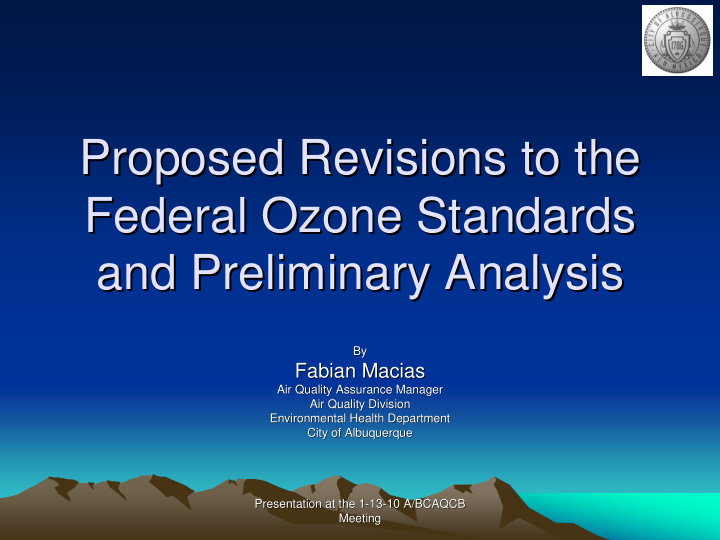



Proposed Revisions to the Proposed Revisions to the Federal Ozone Standards Federal Ozone Standards and Preliminary Analysis and Preliminary Analysis By By Fabian Macias Fabian Macias Air Quality Assurance Manager Air Quality Assurance Manager Air Quality Division Air Quality Division Environmental Health Department Environmental Health Department City of Albuquerque City of Albuquerque Presentation at the 1- Presentation at the 1 -13 13- -10 A/BCAQCB 10 A/BCAQCB Meeting Meeting
Recent Action Recent Action • Based on its reconsideration of the March 2008 federal Ozone Standards, on January 7, 2010 EPA proposed new ranges of Primary and Secondary Ozone Standards. • EPA determined the 2008 Primary Ozone Standard was NOT protective of Public Health and the Secondary Ozone Standard was NOT protective of vegetation and forested ecosystems. • The proposed revised standards are consistent with the recommendations of Clean Air Scientific Advisory Committee (CASAC). Presentation at the 1- Presentation at the 1 -13 13- -10 A/BCAQCB 10 A/BCAQCB Meeting Meeting
Proposed Ozone Action Proposed Ozone Action • EPA is considering setting a Primary Ozone Standard in the range of .060 to .070 parts per million (ppm). This is to ensure the standard is protective of public health with an adequate safety margin. • EPA is also considering setting a new cumulative seasonal Secondary Ozone Standard in the range of 7 to 15 ppm-hours. (ppm) to protect ecosystems. Presentation at the 1- Presentation at the 1 -13 13- -10 A/BCAQCB 10 A/BCAQCB Meeting Meeting
Preliminary Unofficial Analysis Preliminary Unofficial Analysis • If the 2010 Primary Standard is set at 0.070 ppm – 2ZF- Double Eagle Elementary School will be at 100% of the standard @ 0.070 ppm – 2ZV - South Valley will be at 0.066 ppm, the lowest site. • If the 2010 Secondary Standard is set at 15 ppm-hours – 2ZF- Double Eagle Elementary School will exceed the standard @ 16.98 ppm. – 2ZV - South Valley will be at 10.17 ppm, the lowest site. • Our Airshed would be at 100% of the proposed Primary Ozone Standard and exceeding the upper limit of the Proposed Secondary Ozone Standard. Presentation at the 1- Presentation at the 1 -13 13- -10 A/BCAQCB 10 A/BCAQCB Meeting Meeting
Ozone Monitors in Bernalillo County Presentation at the 1- Presentation at the 1 -13 13- -10 A/BCAQCB 10 A/BCAQCB Meeting Meeting
Ambient Air Monitoring Stations – 2ZF and 2ZV 2ZF @ Double Eagle Elementary School 2ZV @ Mountain View Community Center Presentation at the 1- Presentation at the 1 -13 13- -10 A/BCAQCB 10 A/BCAQCB Meeting Meeting
9 Years of Ozone Bernalillo County New Mexico 3 Year Averages, Network High 8 Hour Averages of the fourth highest value as compared to the NAAQS City of Albuquerque, Environmental Health Department, AQD EPA AQS Data 1997 Standard of 0.084 ppm 0.080 0.077 0.077 0.077 March 2008 Standard of 0.075 0.075 0.073 0.073 ppm 0.070 0.070 0.070 2010 0.065 Proposed Range 0.060 Ozone Concentration in PPM 0.055 0.050 0.045 0.040 0.035 0.030 0.025 0.020 0.015 0.010 0.005 0.000 2001-2003 2002-2004 2003-2005 2004-2006 2005-2007 2006-2008 2007-2009 3 Year Averaging Period
Upcoming Air Quality Challenges Upcoming Air Quality Challenges • Maintaining Compliance with the Federal Ozone Standard as they are lowered/strengthened. • Bernalillo County is at about 93% of the Current 2008 Federal Ozone Standard. • Ozone-Levels in Albuquerque Have Dropped in Recent Years, but the Federal Standards for Ozone Have Been Strengthened, or Lowered, at a Faster Rate. • Identifying, Developing and Implementing Effective Control Strategies for Ozone precursors. • Working together to comply with the new standards. Presentation at the 1- Presentation at the 1 -13 13- -10 A/BCAQCB 10 A/BCAQCB Meeting Meeting
Recommend
More recommend